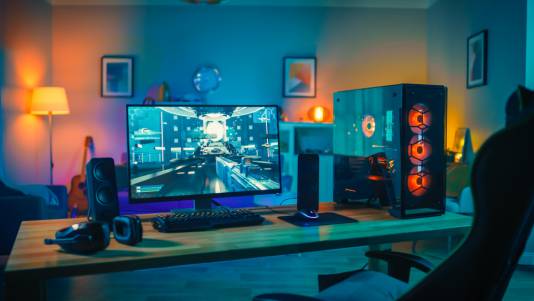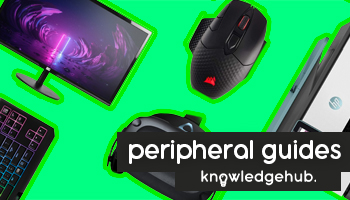Every PC gamer knows that the key to an enjoyable gaming experience is a good set-up. This means having a high-quality monitor, ergonomic peripherals and a gaming PC which can handle the demands of the latest titles.
Whilst a gaming rig is made up of several different pieces of kit each playing their part, we’re going to focus on the monitor and which are the best ones for gaming.
Which are the best monitors for gaming isn’t a question that can be answered easily – and any answer can be subjective, depending on what you would class as the best monitor for your gaming rig. However, there are various aspects that contribute towards a ‘good’ gaming monitor. And to help you choose yours we’re going to break it down, below.
Here’s what you need to consider…
Contributing factors
Here’s a list of all the things you need to consider when choosing your best monitor for gaming. Every factor contributes to the overall experience of the monitor, which is why you need to know exactly how every factor can improve or hinder your monitor’s performance.
We’re looking at everything from monitor size all the way through to the different panel types of a monitor. Understanding what each of the below factors means is important in making an educated decision, and will allow you to choose a monitor based on both price and performance.
Size
When we mention size, we’re talking strictly about the screen size. For gaming the general rule is bigger the better. Your games will look so much more impressive on a 32” monitor than on a 19” screen. In other words, the size of the monitor is going to determine whether your gaming experience is going to be on a cinematic scale or more comparable to that of the small screen.
But of course there are caveats here. Budget being the biggest of them. Not all of us are in a position to splash out on a huge monitor. But do try and buy the biggest monitor your budget allows.
But you also have to consider the space that you’ve got to play with in terms of setting up your gaming rig. You don’t want to choose a huge monitor if you’re only setting up in a small room. The same goes for choosing a small monitor. If you’ve got the space for it, why not maximise it?
Once you’ve decided on how big you want to go, you need to think about aspect ratio…
Aspect Ratio
Don’t be put off by the unusual way aspect ratio is displayed – it’s simple when you break it down.
Aspect ratio is typically displayed as two numbers separated by a colon. For example, the most standard aspect ratio is 16:9, which means that the ratio is 16 parts wide to 9 parts tall. This aspect ratio is also more widely supported, which makes it a great choice when gamers are looking for their first gaming monitor.
Those who are after a more immersive gaming experience may find that a monitor with an aspect ratio of 21:9 is more suitable. This aspect ratio is typical of widescreen monitors, which are better for immersive gaming and watching movies.

Curved or traditional monitors?
The advent of curved screens was something gamers jumped on. Curved gaming monitors look amazing and promise a more immersive experience. They are inevitably more expensive than tradition flat screen monitors so once again budget becomes a factor.
Resolution
Resolution refers to the number of pixels on the screen and is described in the same way as aspect ratio. Often separated by an ‘x’, the screen resolution will be split into the number of pixels across by the number of pixels up.
A full HD monitor has a resolution of 1920 x 1080, which if you were to break it down, means that there are 1,920 pixels across the screen while there are 1,080 pixels up the screen.
The resolution is responsible for what makes images on the screen look crisp and clear, something that can change in relation to the monitor’s physical size. In simple terms, if a 24” monitor has the same aspect ratio as a 30” monitor, the image clarity will be better on the small screen. This is due to the pixels needing to be bigger to fill the larger screen whilst maintaining the same 1920 x 1080 aspect ratio.
If this raises some concern over whether or not you’ve got a monitor which can display high-quality imagery, just remember there are 4K monitors available. 4K UHD (Ultra High Definition) monitors have a resolution of 3840 x 2160 pixels, which means they provide unrivalled image quality and are one of the best gaming monitors you can find on the market.
Shop monitors at Ebuyer
Refresh rate
The refresh rate refers specifically to how many times the screen is refreshed. Of course, the higher the refresh rate the smoother gameplay and movies will be. Bear that in mind when making your choice.
The most common refresh rate you’ll find is 60Hz, which means that the screen is refreshed 60 times per second. Now, although this will display all gameplay and movies perfectly fine, it isn’t the best available.
Higher end gaming monitors now boast refresh rates of up to 120Hz and 144Hz, both of which provide an impeccable gaming performance. But, as we all know, with great power comes great responsibility, and in this case that responsibility falls to the graphics card.
If you opt for a monitor with a refresh rate of 120Hz, you need to make sure that your graphics card is capable of refreshing at 120 frames per second, otherwise you’re wasting all the extra refresh rate potential of your monitor.
Syncing your graphics card & monitor
All this talk of frames and ‘Hz’ may scramble your brain, but getting it right is an important step towards ensuring an enjoyable gaming experience. As mentioned above, if your monitor is running at a refresh rate of 120 times per second, you need to make sure that your graphics card is synced to the same refresh rate.
A graphics card and monitor are not in sync automatically and, as a result, tearing can occur. This is when two separate frames become overlaid with one another, breaking up the image displayed on screen. As you can imagine, this is something you want to avoid at all costs.
That’s why it’s important to double check that the graphics card you’re buying features technology that ensures your monitor and graphics card are in sync. Both AMA and NVIDIA include their own versions of this technology and will ensure that your monitor and graphics card refresh rates are in sync to avoid any visual issues.
Response Time
The response time of a monitor is how long it takes a pixel to change colour. You may think that this is just the same as the refresh rate, but these are entirely different. Response time refers solely to the individual pixels and nothing else, unlike the frame rate which also relies on the capability of a graphics card.
If the response time is anything above 10ms (milliseconds), the colour change would become visible to the user and result in pixel ghosting. This often occurs during fast paced scenes and is when a pixel is unable to change colour fast enough to keep up with the image.
Bear this in mind when choosing the best monitor for gaming, as you’ll want to go for a monitor with a response time of 4ms or less. If you’re looking for a monitor with a response time of less than 4ms, you’ll need to go for TN panel, as IPS panels can only achieve 4ms.
Which leads us onto our next factor to consider…
Panel types
When it comes to panel types of gaming monitors, there are two to choose from. These different types of panel are:
- IPS (In-plane-switching)
- TN (Twisted nematic)
Each type of panel offers its own benefits and is more suited to certain types of gaming. For example, a TN panel is more suitable for fast-paced, competitive gaming due to its high response time. However, the TN panel lacks in colour vibrancy so don’t expect a mind-blowing visual display.
The IPS panel, on the other hand, offers much greater colour reduction and brighter images, which a lot of gamers prioritise when choosing their gaming monitor. But where the TN panel excels in high response time, the IPS monitor lacks, meaning it’s generally better for slower paced games and graphics heavy videography work.
Trying to explain the ins and outs of TN and IPS panels without a demonstration is a little difficult, after all it’s all about what it looks like. Which is why we’ve created this video to explain the pros and cons of each monitor in more depth.
(IPS vs TN vs VA panels video – https://www.youtube.com/watch?v=F6u5OauqQv0 )
Shop monitors at Ebuyer
In summary
Now you know the finer details of what contributes towards the best monitors for gaming.
There are quite a lot of things which need to be taken into consideration – and it’s a hefty amount of information to take in during one sitting. So, let’s break it down into a summary of bite-sized chunks.
- Size – Choose a sensible sized monitor in relation to how much room you have to set up your gaming rig. For a fully immersive experience, aim big, but don’t forget about aspect ratio.
- Aspect ratio – If you’re a beginner, a monitor with an aspect ratio of 16:9 is a good place to start. If widescreen monitors are more your bag, then a monitor with an aspect ratio of 21:9 will be more suitable for you.
- Resolution – A full HD monitor with a resolution of 1920 x 1080 will provide a perfectly good picture, but if you’re a stickler for details then a 4K monitor with a higher resolution of 3840 x 2160 would be a better choice.
- Refresh rate – A monitor with a refresh rate of 60Hz is fine for any entry-level gamer. However, if you’re itching for more fluid gameplay then you’ll find a 120Hz or 144Hz monitor more satisfying.
- Response time – 4ms is a standard response time for a great gaming monitor. Lower response times will do a better job of keeping up with the most demanding games, but don’t forget you’ll need to consider the panel type!
- Panel type – If first-person shooters are your go-to, you’ll want to go for a TN panel as they’re designed for fast-paced games. Whereas IPS panels more suited for large open world games and will provide much brighter imagery.
Gaming monitors at Ebuyer
As you can see, there a several factors that make up a gaming monitor and each holds its own sway on how the monitor performs. Now that you know what different things need to be taken into consideration, you can make a much better-informed decision.
At Ebuyer we pride ourselves on providing avid gamers with the tech that they need to enjoy the best experience possible. To accommodate all gamers, we’ve stocked up on an extensive range of gaming monitors, from a variety of reliable brands, which cover all bases and service all the factors mentioned above.



